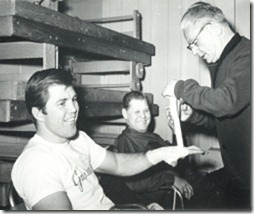 By Ted Sares:
By Ted Sares:
There is something so bitterly cruel and ironic about a fighting man not being able to remember the one glorious and exceptional quality that set him apart from the rest.
—Mike Casey
This is not an unpleasant place. There might even be a garden outside with benches upon which the sun shines warmly. The sound of birds singing may be heard by those who can still hear. Polite and helpful attendants with white uniforms move about, while visitors sit quietly with the patients. However, meaningful conversations are not commonplace. There is a sense of temporariness or “just passing through” that is unmistakable.
Most here are locked in a clouded emotional prison punctuated with stares that see very little. They hear voices no one else hears, and they often scream at night. Some sit in wheelchairs semi-paralyzed; others lie in bed unable to see, having to be fed and otherwise cared for. Some shuffle around without knowing their destination. Occasionally, a flash of glory is recalled. But soon the flashes cruelly evanesce, leaving the inhabitants to resume their blank stares with eyes glazed over. They are often confused, childlike, and uttering unintelligible sounds delivered by thick tongues. The more fortunate have friends or relatives to help out.
Eventually, they will need to be cared for like infants, for this terrible thing they have is degenerative and unforgiving, and its symptoms often emerge once the victim is in his later years, long after retiring from the career that gave rise to the condition.
Some who have not yet arrived are huddled in lonely doorways or in subway stations on a frigid night; some are looking for aluminum cans in alleyways in some junkyard to turn in for some extra change. Still others shuffle unsteadily from one flea-bitten hotel to another. Their world is one of irreversible sameness. They all seem to talk alike, slurring their words with a nasal monotone, and sometimes engaging in self-directed temper tantrums.
The symptoms are similar to that of alcohol intoxication, but this malady is worse. They have speech difficulty, dizziness, and involuntary muscular movements—their hands tremor. Their balance is unsteady, and their short-term memory is rapidly deteriorating. Their cognitive ability is all but gone. They have a problem engaging in the most simple of daily activities or in working menial jobs; and they also have a tendency to wander. Once the conditions exist, there is no other choice but to deal with it and make the most out of what limited treatments are available. Soon, they will become eligible for admittance, but until then, they must exist from day to day as best they can.
These unfortunate few are all victims of the legalized violence of boxing, where the risk-reward equation was never in their favor. Most are unknown and will be forgotten. The legacies of those who are known will be kept alive by their fans long after they have left this world.
Dementia pugilistica
If you’ve got problems on a CAT scan, you’re too darn late…
Dr. Battaglia of Oregon, “Too Many Punches, Too Little Concern.” SI Vault. 4-11-83
People with this kind of mental damage are sometimes described as being punch-drunk or punchy. Those words are both demeaning and terribly misleading. A better way to describe it is to use diagnostic terms such as chronic traumatic encephalopathy (CTE). For the politically correct, the condition, which occurs in people who have suffered multiple concussions, commonly manifests itself as dementia or declining mental ability. It also can result in Parkinson’s tremors and lack of coordination. But plainly stated, it is dementia pugilistica (aka boxer syndrome), nothing more and nothing less. It’s a condition caused by being on the receiving end of too many blows to the head and it is horrific.
Boxers with dementia pugilistica can also exhibit symptoms resembling other degenerative disorders, including: Parkinsonism (which Muhammad Ali showed signs of at age 38 and was diagnosed with in 1984), Dementia, Alzheimer’s disease, Wernicke-Korsakoff syndrome, and Kluver-Bucy syndrome.
While other injuries such as cuts and fractures can be repaired, brain tissue, once damaged, remains damaged. The boxer can recover from a broken nose; however, severe brain damage is permanent. More than a single blow or knockout punch, it is the accumulation of punches, endured over a period of time, both in actual fights and during the many rounds of gym training.
Now it’s not pleasant to say where this place is. Some refer to it colloquially as “Palookaville,” but it’s far worse than that. This place is at the end of a one-way, irreversible descent, ending where cerebral atrophy occurs and where the brain rapidly shrinks with dead cells dissolving into liquid. Finally and mercifully, the all-but-dead brain eventually begins to shut down, and a decision must be made to remove life support, which in turn will result in cardiac arrest—and that’s what they mean when they say someone had died from complications of dementia pugilistica. And that’s where it all finally ends.
No bell tolls with the final ten count for these fallen warriors. Here, the thousands of rounds in the gym during which the blows landed upon their skull offset any possible lingering feeling of invincibility. Here, there is neither denial nor hope. No more triumphs. No romanticizing. The machines are turned off. The bulb flickers, dims, and goes out. Then all becomes dark.
May God bless Denny and Phil Moyer, Jerry and Mike Quarry, Jimmy Young, Joe Louis, Willie Pep, Sugar Ray Robinson, Floyd Patterson, Johnny Saxon, and all the others who gave us so much joy when they fought.
Postscript: Denny Moyer is featured in the documentary, “After the Last Round,” a film that is scheduled to be released this fall and focuses on the risks of boxing and how it affects families.